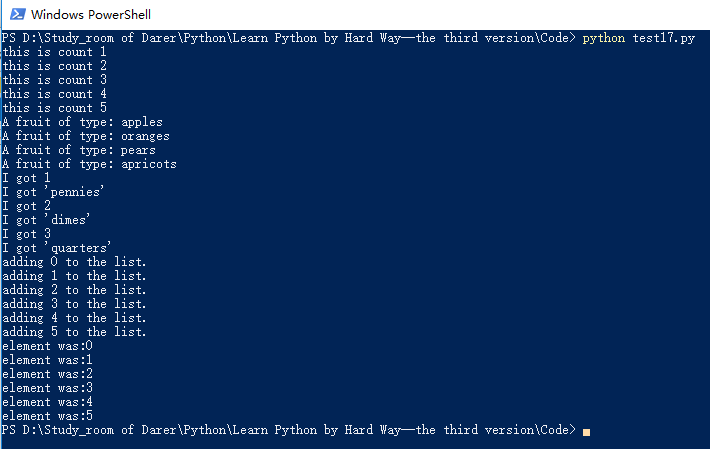Python系列之笨方法学Python是我学习《笨方法学Python》—Zed A. Show著
的学习思路和理解,如有不如之处,望指出!!!
本节主要学习for循环语句和如何创建一个列表
源代码
# ex32.py
the_count=[1,2,3,4,5]
fruits=['apples','oranges','pears','apricots']
change=[1,'pennies',2,'dimes',3,'quarters']
#this first kind of for-loop goes through a list
for number in the_count:
print "this is count %d"%number
#same as above
for fruit in fruits:
print "A fruit of type: %s"%fruit
#also we can go through mixed lists too
#notice we have to use %r since we don't know what's in it
for i in change:
print "I got %r"%i
#we can also build lists,first start with an empty one
elements=[]
#then use the range function to do 0 to 5 counts
for i in range(0,6):
print "adding %d to the list."%i
#append is a function that lists understand
elements.append(i)
#now we can print them out too
for i in elements:
print "element was:%d"%i
应该看的结果

这里需要注意的一点:
注意%r和%s输出结果的不同
这个知识点,前面有介绍过
本节需要学习的知识
range()指令
range() 函数可创建一个整数列表,一般用在 for 循环中
标准语法
range(start, stop[, step])
参数说明
- start: 计数从 start 开始。默认是从 0 开始。例如
range(5)等价于range(0,5); - stop: 计数到 stop 结束,但不包括 stop。例如:
range(0, 5)是[0, 1, 2, 3, 4]没有5 - step:步长,默认为1。例如:
range(0, 5)等价于range(0, 5, 1)
示例
>>>range(10) # 从 0 开始到 10
[0, 1, 2, 3, 4, 5, 6, 7, 8, 9]
>>> range(1, 11) # 从 1 开始到 11
[1, 2, 3, 4, 5, 6, 7, 8, 9, 10]
>>> range(0, 30, 5) # 步长为 5
[0, 5, 10, 15, 20, 25]
>>> range(0, 10, 3) # 步长为 3
[0, 3, 6, 9]
>>> range(0, -10, -1) # 负数
[0, -1, -2, -3, -4, -5, -6, -7, -8, -9]
>>> range(0)
[]
>>> range(1, 0)
[]
append()指令
append() 方法用于在列表末尾添加新的对象。
标准语法
list.append(obj)
参数说明
- obj – 添加到列表末尾的对象。
- 如何创建二维列表
就是在列表中包含列表,如[[1,2,3],[4,5,6]]
这是**《笨方法学Python》**的第十七篇文章
希望自己可以坚持下去
希望你也可以坚持下去








 本文深入探讨Python中的for循环语句,展示如何使用for循环遍历列表,并讲解range()和append()函数的使用,同时介绍了二维列表的创建方法。
本文深入探讨Python中的for循环语句,展示如何使用for循环遍历列表,并讲解range()和append()函数的使用,同时介绍了二维列表的创建方法。

















 被折叠的 条评论
为什么被折叠?
被折叠的 条评论
为什么被折叠?








